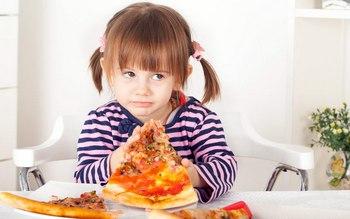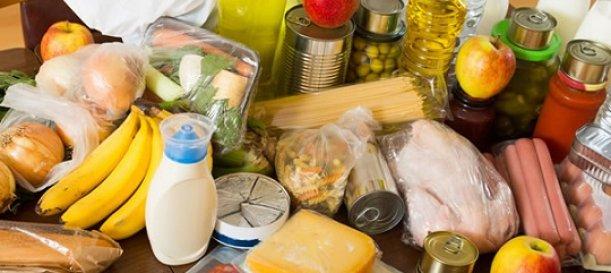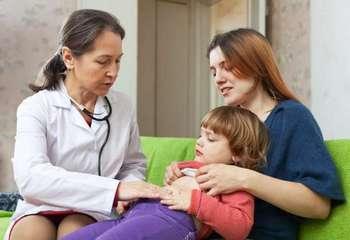Childish food poisoning

- Main types of childish food poisoning
- What products are considered to be potentially dangerous?
- How food poisoning gets evident?
- How to behave when a child is poisoned?
- How is food poisoning treated?
- Sorbents in treatment of food poisoning
Food poisoning is an acute non-contagious disease caused by toxins entering human body with foodstuffs. It features no age restrictions. But children are more prone to food poisoning, which is explained by the functional immaturity of their immune and digestive systems. Therefore, child's body is not yet able to resist acting toxins entering the gastrointestinal tract to the fullest. The response can be quite pronounced, which sometimes represents a certain lofe danger.
After poisoning, the child does not develop a permanent immunity. This explains possibility of recurrence of the disease, and the food toxins are different.
Main types of childish food poisoning
Depending on the cause, there are 2 types of food poisoning in the child:
- Infectious nature associated with microbes and their toxins entering gastrointestinal tract.
- Non-infectious caused by child`s consuming poisonous substances of vegetable or animal origin.
Infectious poisoning in a child is most often caused by having food contaminated with a large number of microbes. The most common of them are salmonella, proteus, E. coli, clostridia, listeria. Some of them are uniquely pathogenic, others are related to the conditionally pathogenic flora and can be discovered in some quantity in intestines of healthy people .
The bacteria are dangerous not only in a living form. While dying and destroying, they release endotoxins (toxic substances stored in cells). They enter sufferer`s blood and negatively affect performing vital organs and the whole body as a whole. This kind of is labeled as food poisoning in medicine.
Some bacteria actively produce poisonous substances in the process of their vital activity. They are called exotoxins. They can persist in meal for a long time after the microorganisms die. If childish poisoning is caused by these substances entered, its diagnosis is called food bacterial toxicity. The example is botulism.
What products are considered to be potentially dangerous?

Potentially dangerous bacteria can be found on almost all products. But for occurring poisoning symptoms in children they need to get into the body in a sufficiently large number. Therefore, alertness should be provided in relation to treating products first of all, because they can become a breeding ground for developing harmful bacteria.
They include:
- Dairy products with a short shelf life and especially with already opened packaging. The most dangerous are ice cream and cottage cheese.
- Eggs.
- Fish and seafood products.
- Confectionery cream products.
Of course, children should not be deprived of the products. After all, many of them are a source of useful nutrients necessary for growth and development. But it is necessary to pay attention to the quality and freshness of the products used to feed the baby. Poisoning is often a consequence of the repeated thawing, prolonged presence in room temperature, insufficient heat treatment. Teach children cook and have healthy high-quality home meal, acquaint them with the product storage rules.
How food poisoning gets evident
Food poisoning features short incubation (latent, pre-symptomatic) period. The first signs of the disease usually develop quite sharply, by the end of the first day after infection. And with non-infectious poisoning, a child can get worse after a few hours after taking a poisonous product.
The time of appearing and rate of increasing symptoms depend on the rate of absorption of toxins in the digestive tract. Sometimes, a sick kid gets worse gradually, step by step. But growth of symptoms is possible and rapid too, including developing life-threatening infectious-toxic shock.
Main signs of food poisoning include:
- Nausea. This symptom usually appears one of the first and is quickly supplemented with vomiting. In 1-year old children, the equivalent of nausea is increased salivation.
- Vomiting. It is noted in almost all cases. When poisoned, the child can experience severe, debilitating vomiting that can quickly lead to dehydration.
- Diarrhea (rapid fluid stools). Childish diarrheacombined with poisoning appears after a while and is associated with intestine`s reation to bacteria and their toxins. It can be of different severity - from a semi-shaped stool several times a day to multiple watery excretions. Usually it is combined with cramping pains in the abdomen. And after a while, false desires for defecation (tenesmus) may join.
- Appearing abnormal impurities in feces, i.e. clots of mucus, greenish impregnations, veins of blood.
- Fever. When poisoned, the child`s temperature usually rises after a while and hardly reaches high figures. And with non-infectious nature of the disease, it can at all remain within the norm.
- Signs of general intoxication: malaise, weakness, headaches, tachycardia (palpitations).
- Symptoms of dehydration arising against a background of repeated vomiting and diarrhea. These include drying mouth mucous membranes, skin dryness and flabbiness, some lowering blood pressure and volume of excreted urine and its darkening. The younger the child, the faster dehydration develops.
With non-microbial food poisoning, signs of damaged brain and internal organs can appear. However, intestinal symptoms are usually quite weak. And with botulism, they can be absent.
How to behave when a child is poisoned
Do not underestimate potential danger of childish food poisoning. Even if the child initially feels relatively good, its condition can quickly go down. This is due to the absorption of an increasing number of toxins in its intestines, adding and growing dehydration, deteriorating cardiovascular system against the background of intoxication.
Therefore, consult the doctor as early as possible, even if the child's condition does not cause serious fear. But do not neglect first aid measures.
What should I do at home when my child is poisoned?
- Pump the stomach. This will remove unabsorbed unentered toxins. But pumping must not be done independently in babies suffering from serious conditions, because in these cases the risk of inhaling vomit is high enough.
- Give the baby enterosorbents. They are preparations "collecting" toxins in the lumen of the intestine and then excreting them with feces. If it is not possible to carry out lavage of the childish stomach, treatment of poisoning should be started precisely with giving the child enterosorbents.
- Ensure sufficient fluid intake to reduce the risk of severe dehydration. In this case, do not force the child to drink a lot, since this can provoke vomiting. It is recommended to let it make afew sips every 15-20 minutes, offering a weak saline solution, weak tea, mineral water (without gas). The infants are supplemented with water or special rehydrating saline solutions.
These measures are usually enough to wait for the doctor to examine sick child. Further treatment of poisoned children should be carried out under the supervision of a specialist.
Do not start taking antimicrobial drugs at your will, because this can provoke a massive death of bacteria and releasing significant amount of endotoxin. In addition, while providing antibacterial treatment, it is very important to choose the optimal dosage taking into account the child's age and other factors. Only a doctor can do this competently. The specialist should decide what to give a child when poisoned. Folk techniques (for example, taking rice or oat broth, cinnamon or another herbal tea) can also be used only according to the doctor`s advice.
How to treat food poisoning
 When child suffers from food poisoning, treatment is prescribed taking into account a number of factors. Consideration is given to the cause of the disease, age and general condition of the small patient, the severity of his intestinal symptoms and signs of dehydration.
When child suffers from food poisoning, treatment is prescribed taking into account a number of factors. Consideration is given to the cause of the disease, age and general condition of the small patient, the severity of his intestinal symptoms and signs of dehydration.
The basic scheme for treating poisoning of microbial origin is:
- Taking sorbents to reduce toxins concentrated in the gastrointestinal tract.
- Antibacterial therapy to eliminate bacteria that caused poisoning.
- Using prebiotics to maintain normal intestinal microflora.
- Symptomatic therapy. It is prescribed, if necessary, to replenish the lost fluid and minerals, maintain functioning of the cardiovascular system and other organs.
Sorbents in the treatment of food poisoning
Sorbents are now considered as key drugs for treating food poisoning. After all, it is thanks to them that it is possible to reduce the severity of intoxication at the early stages of the disease, when the antimicrobial agents prescribed were not yet in effect. Properly selected sorbents are also able to reduce severity of nausea, vomiting and diarrhea. This will reduce risk of rapid dehydration and developing other complications.
When choosing sorbent for the complex treatment of food poisoning in children, preference should be given to modern remedies approved for applying by 1-year old baby. It is desirable that they also do not irritate the stomach, are not absorbed and have a wide range of adsorption capacity. All these requirements are met by Filtrum®, a lignin-based preparation made from wood. It is able to bind and remove pathogenic bacteria, toxins of microbial and non-microbial origin, an excess of some metabolic products formed in the body out of the intestine. Filtrum® can be applied to detoxify during food poisoning in 1-year old children.
Important: Before using, read the instructions or consult your doctor.










